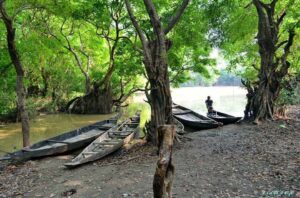This blog was written for the RSA Blog Student Summer Series that will highlight graduate student success in regional studies across the globe throughout the summer.
We have witnessed many instances of migration and displacement due to conflicts, violence or genocide in the modern world. It has caused much harm to lives, property and communities. However, in the 21st century, a new kind of migration is creating attention; migration induced by climate change. Even after the transition from the UN Millenium Development Goals to the Sustainable Development Goals in 2015, we are far from achieving the desired goal. The rise of sea-levels, loss of livelihood to nature and unsustainable developmental projects are creating havoc and forcing quite perceptible and imperceptible movement of the human population. This blog looks at the causes, impact and possible policies to help mitigate the challenge.

Region in the Sunderbans
What is causing such migration?
Sunderbans is the largest mangrove forest reserve, an UNESCO World Heritage site and home to the exotic Royal Bengal Tigers. Apart from the Bengal tigers, Sunderbans is also home to a large population of people. Small clustered villages on the soft clay muds are found in the Bay Area. Fishing and collecting honey is the primary source of livelihood as other alternatives of income are restricted by natural and administrative limitations. The immense impact of sea-level rise is forcing the villagers to leave their homes and migrate to the urban areas or even other states of India.
The migrants who go to work in other states often face marginalization and social exclusion due to cultural and language barriers. The poor economic and industrial condition of West Bengal, from where these migrant workers are; further force them to look for jobs in other states to make ends meet and if possible, to send back some savings to their ailing families.
The cause of the migrant workers in India grew in importance during the Covid-19 pandemic when they were coerced to undertake long tedious journeys back home, worsened by the sudden stringent lockdown and quarantine norms. When the lockdown was lifted and the economy began to recover, people started migrating again to look for gainful employment. The extremely competitive and disproportionate wage of the daily-wage workers in different states presents a stark contrast.
The migrant workers, in a different state, are denied the right to vote due to their polling booth in their home constituency. India, being a vastly diverse country, the workers are left to face linguistic, cultural, religious and regional barriers. They find difficulty in communicating and there is lack of coordination. The migrant laborers have to work extra hard to be able to keep pace in an alien culture. Many states in India have a large population of migrant workers who do not live in the state of their origin.
Impact of climate change on rural communities
While the look for a decent livelihood has pushed many men away from their original villages, they leave behind their families; the women, children and the elderly. Sagar Island, one of the biggest in the Sunderban archipelago yet is struggling to tackle school drop-out rates. Due to social and climatic stresses, girls are married off early. It is also viewed as a relief from the financial burden of upbringing and educating girl children. The vulnerability of the girls makes them susceptible to trafficking to the rest of India. West Bengal has reported the highest number of girls missing according to registered data. The difficulty of establishing long-term developmental institutions in the area due to loss of land makes the situation far more worse. The Sunderbans also sees the deadliest cyclones and its impact is almost unrecoverable.
Efforts to help the affected families
There is an urgent need to provide government and non-government assisted aid to both the migrant laborers and the families left in their hometown. States in South India such as Kerala, Tamil Nadu have recently created separate registries to track and record the daily laborers from different states. The respective state governments have made an effort to recognise their cultural rights and assimilate them into the society.
Several NGOs in South Bengal work tirelessly along with the schools and other self-help groups to secure their homes and livelihood. The dedicated effort by the school teachers to keep an eye on all students who are not attending schools is also notable. The school teachers are calling and visiting the student’s home to enquire about their absence and in many cases, urging parents of girl children to not get them married and get them readmitted to schools.
One undeniable fact is that climate change is not simply an ecological issue, but must be viewed as it has become intertwined with cultural, social and economic aspects.

Utsa Maity is a final year Political Science undergraduate student at the University of Calcutta. She has interned at several Indian think-tanks on policy analysis and policy-making, and as a junior political consultant at I-PAC. She aims to pursue higher education in International Relations and Development to work in the development sector with an impact.
Are you currently involved with regional research, policy, and development? The Regional Studies Association is accepting articles for their online blog. For more information, contact the Blog Editor at rsablog@regionalstudies.org.